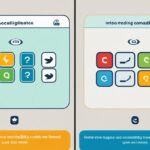Table of Contents
Welcome to our comprehensive guide on email marketing accessibility. In today’s digital era, it is crucial to ensure that your email content is accessible to all recipients, including those with disabilities. With approximately one billion people worldwide experiencing some form of disabilities, inclusive email marketing is not only a moral obligation but also a strategic approach to reach a wider audience and improve engagement. By implementing best practices for email accessibility, you can create content that removes barriers and maximizes your campaign’s impact.
Accessible email content benefits not only people with disabilities but also enhances usability and engagement for all recipients. In this article, we will explore the best practices for creating inclusive and accessible email content that meets the needs of a diverse audience. We will cover topics such as email subject lines, designing accessible layouts, creating accessible images and alt text, ensuring readable text and links, and considering technical compatibility and support. By embracing these practices, you can create a more inclusive and user-friendly email marketing experience.
Throughout this guide, we will provide you with valuable insights and actionable tips to help you implement email marketing accessibility best practices. Our goal is to empower you to create accessible content that resonates with all recipients and drives meaningful engagement. So, let’s dive in and explore the world of email marketing accessibility together.
Why Email Accessibility Matters
Email accessibility plays a crucial role in reaching a diverse audience and ensuring that your email messages are inclusive for everyone. By making your email content accessible, you can accommodate the needs of people with various disabilities, such as visual impairments, motor disabilities, cognitive and neurological disorders, and hearing impairments. This not only enhances the user experience for individuals with disabilities but also benefits your overall marketing strategy.
There are several important reasons why email accessibility should be a priority:
- Improved Engagement: Accessible email content makes it easier for all recipients to consume and interact with your messages. By removing barriers to accessibility, you can increase engagement and encourage recipients to take desired actions.
- Enhanced Trust and Credibility: When you prioritize email accessibility, you demonstrate your commitment to inclusivity and create a positive impression of your brand. This can help establish trust and credibility with your audience.
- Competitive Advantage: In a crowded digital landscape, accessible email marketing can set you apart from competitors. By offering inclusive and accessible content, you position your brand as one that values diversity and inclusivity.
- Legal Compliance: Ensuring email accessibility helps you minimize legal risks and comply with accessibility standards and regulations. By meeting accessibility requirements, you protect your brand reputation and avoid potential legal consequences.
- Maximized Reach: Making your email content accessible allows you to reach a wider audience, including people with disabilities. This expands your potential customer base and increases your chances of connecting with diverse demographics.
By embracing email accessibility, you can create a more inclusive digital marketing strategy that benefits both your audience and your brand. It demonstrates your commitment to reaching all individuals and allows you to tap into the diverse potential of your target market.
“Accessible email content creates an inclusive digital marketing strategy that maximizes reach and enhances engagement.”
Email accessibility is not just a moral responsibility; it is also a strategic move that can enhance your brand reputation, increase engagement, and build trust with your audience. By ensuring email accessibility, you open doors to a more inclusive and successful digital marketing journey.
Best Practices for Email Subject Lines
Subject lines play a crucial role in determining whether recipients will open your emails. To ensure accessibility, subject lines should be brief but descriptive, providing an accurate idea of the email’s content. Effective subject lines not only improve accessibility but also increase overall engagement.
By using concise and descriptive subject lines, you can communicate the purpose of your email effectively to all recipients, including those who rely on screen readers. A well-crafted subject line captures attention and entices recipients to open your email, making it inclusive for all users.
Consider the following tips when creating accessible subject lines:
- Keep it concise: Aim for subject lines that are around 6 to 8 words long, conveying the main message without being too lengthy.
- Be descriptive: Provide a clear and accurate summary of the email’s content in a way that enables recipients to quickly understand what the email is about.
- Avoid vague language: Steer clear of generic phrases or ambiguous language that may confuse or mislead recipients. Instead, use specific and relevant terminology.
- Use keywords strategically: Incorporate relevant keywords in your subject line to optimize accessibility and improve searchability.
- Avoid excessive punctuation and capitalization: Excessive use of punctuation marks and capital letters can make subject lines appear spammy and negatively impact accessibility. Use them sparingly for emphasis only when necessary.
Accessible subject lines benefit all recipients by providing clear and concise information about the email’s content. By following these best practices, you can ensure that your subject lines are inclusive, engaging, and accessible to all users.
“A well-crafted subject line captures attention and entices recipients to open your email, making it inclusive for all users.”
Designing Accessible Email Layouts
When it comes to email design, creating accessible layouts is essential to ensure that your content reaches all recipients, regardless of their device or assistive technologies. By following best practices for accessible email design, you can enhance the user experience and make your emails inclusive for everyone. In this section, we will explore the importance of responsive email templates and easy navigation for screen readers.
Responsive Email Templates
A responsive email template is designed to adapt to different screen sizes and devices, ensuring that your content is displayed appropriately. This is especially important as more people access their emails on mobile devices. By using responsive email templates, you can prevent distorted layouts and guarantee that your message is delivered consistently across all devices.
Here are some key considerations for designing responsive email templates:
- Use fluid layouts: Design your email templates with relative widths and proportions instead of fixed pixel values. This allows your content to adjust automatically based on the screen size.
- Optimize images: Compress and resize images to reduce file size and improve loading times on mobile devices.
- Test on multiple devices: Ensure that your email templates are tested on various devices and email clients to guarantee compatibility and consistent display.
Screen readers are assistive technologies that read aloud the content of a webpage or email for people with visual impairments. To make your email content easily navigable for screen reader users, it’s crucial to structure your email using proper HTML heading attributes.
Here are some tips for easy navigation with screen readers:
- Use heading tags: Use
,
,
, and so on to structure your email content. These tags help screen reader users navigate through the different sections of your email more efficiently.
- Provide clear and concise headings: Use descriptive headings that accurately summarize the content of each section. This helps screen reader users understand the context and find the information they’re looking for.
- Avoid using tables for layout: Tables can be challenging for screen readers to interpret correctly. Instead, use CSS and semantic HTML to structure your email templates.
| Benefits of Designing Accessible Email Layouts | Challenges of Inaccessible Email Layouts |
|---|---|
| Improved user experience for all recipients | Exclusion of people with disabilities |
| Increased engagement and click-through rates | Loss of potential customers or subscribers |
| Brand reputation enhancement | Poor accessibility compliance and legal risks |
Creating accessible email layouts not only benefits people with disabilities but also improves engagement and fosters a positive brand image. Ensure that your email templates are responsive, adaptable to different devices, and provide easy navigation for screen readers. By following these best practices, you can create email designs that reach a wider audience and provide an inclusive user experience.
Creating Accessible Images and Alt Text
Images play a vital role in email marketing, but they can present challenges for individuals with visual impairments or recipients who have disabled images in their email clients. To ensure Image Accessibility and make your content inclusive, it is essential to provide alternative text, known as alt text, for all of the images in your emails. Alt text should be concise yet descriptive, providing relevant information about the image content. By including alt text, you enable screen readers to read aloud or display the description in place of the image, making the content accessible to all recipients.
When creating alt text, it is important to follow Alt Text Best Practices. Consider the purpose and context of the image and aim to provide a descriptive summary in a few words. Describe the image accurately, including relevant details and any pertinent information that the recipient may miss out on without seeing the image itself. However, it is equally important not to make the alt text too lengthy or verbose, as this can be overwhelming for screen reader users.
For example, if the image in your email is a new product launch, the alt text could be “Image: XYZ New Product Launch – A sleek and innovative XYZ product in vibrant blue color, being showcased by a model in a modern setting.”>
Descriptive Image Descriptions
By providing descriptive image descriptions through alt text, you can ensure that recipients who rely on screen readers can fully comprehend and engage with your email content. The alt text acts as a textual representation of the image, capturing its essence and conveying the visual elements effectively.
Here is an example of how alt text can be used effectively in an email:
“At XYZ Company, we believe in the power of teamwork. This image showcases our diverse team working together to achieve our goals. Image: A group of diverse professionals collaborating in a modern office environment, exchanging ideas and smiling.”
Descriptive alt text not only makes your content accessible to individuals with disabilities but also improves the overall user experience for all recipients, including those who have images disabled in their email clients.
Image: An illustration showing the importance of designing accessible images and providing alt text.
Alt Text Best Practices
| Best Practice | Description |
|---|---|
| Be concise | Summarize the image in a few words without being overly verbose. |
| Be descriptive | Provide relevant details and convey the meaning of the image effectively. |
| Consider context | Take into account the purpose and context of the image when crafting the alt text. |
| Avoid empty alt text | Ensure that alt text is present for all images, even if it is just decorative or functional. |
Designing Readable Text and Links
Creating readable text in emails is crucial for accessibility. By following typography best practices, you can ensure that your email content is legible and user-friendly.
Here are some tips to design readable text in your emails:
- Use legible sans-serif fonts, such as Arial or Helvetica, to improve readability on different devices and platforms.
- Choose an adequate font size that is easily readable. A minimum font size of 14 pixels is recommended for body text.
- Ensure appropriate color contrast between the text and background to make it accessible to all recipients.
- Avoid center-aligning text as it can make it harder to read. Instead, opt for left alignment for better readability.
When adding links to your email, it is important to make them accessible and descriptive. Here are some best practices for creating accessible links:
- Use descriptive anchor text that clearly indicates where the link will lead. Instead of using vague link text like “click here,” provide context to guide recipients.
- For example, instead of “Click here for more information,” use “Learn more about our products and services.”
By following these typography and link design best practices, you can ensure that your email content is easily readable and accessible to all recipients.
Example:
“We believe in providing a seamless user experience for all our customers. That’s why we prioritize email accessibility and follow best practices for designing readable text and links. We use legible sans-serif fonts like Arial or Helvetica, with an adequate font size of 14 pixels for body text. Our color contrast is carefully chosen to ensure accessibility, with appropriate contrast between text and background. We also avoid center-aligning text to improve readability and left align our content. When adding links, we use descriptive anchor text that clearly indicates where the link will lead. We believe that designing accessible emails not only enhances the user experience but also reflects our commitment to inclusivity and equal access.”
Additionally, incorporating visual elements that aid comprehension can enhance the readability of your emails. Consider adding relevant images with descriptive alt text to provide further context and engagement for all recipients.
Considering Technical Compatibility and Support
In addition to addressing human disabilities, it is important to consider technical compatibility and support when creating accessible emails. Different email clients, browsers, and operating systems can affect how your emails are rendered. It is crucial to ensure that your email design and code are compatible with a range of clients and devices, including mobile devices. By testing your emails across various platforms and making necessary adjustments, you can ensure consistent accessibility and usability for all recipients.
Email Client Compatibility
When designing accessible emails, it is essential to consider compatibility across different email clients. Each client may interpret HTML and CSS differently, which can impact the appearance and functionality of your email. Test your emails on popular email clients, such as Gmail, Outlook, and Apple Mail, to ensure consistent rendering and functionality.
Browser and OS Considerations
Browser and operating system (OS) compatibility is another crucial aspect to consider when creating accessible emails. Different browsers, such as Chrome, Firefox, and Safari, may have varying support for HTML and CSS features. Similarly, different operating systems, like Windows, macOS, and iOS, can influence how your emails are displayed. Test your emails across multiple browsers and operating systems to ensure a seamless experience for all recipients.
Screen Size Adaptation
With the increasing use of mobile devices, it is important to design emails that adapt to different screen sizes. Responsive design ensures that your email content is displayed optimally on various devices, including smartphones and tablets. Test your emails on different screen sizes to ensure that the content remains accessible and readable, regardless of the device used.
To demonstrate the importance of screen size adaptation, consider the following example:
| Device | Screen Size |
|---|---|
| iPhone 12 | 6.1 inches |
| iPad Pro | 12.9 inches |
| Samsung Galaxy S21 | 6.2 inches |
By designing your emails to adapt to different screen sizes, you can ensure that your content is easily accessible and readable, providing a seamless experience for all recipients.
Conclusion
Ensuring email marketing accessibility is not only the right thing to do but also a strategic approach to reach a wider audience, improve engagement, and build trust with your recipients. By implementing best practices for email subject lines, design, image accessibility, readable text, and considering technical compatibility, you can create accessible email content that is inclusive and maximizes your reach.
Embracing email accessibility as part of your marketing strategy demonstrates your brand’s commitment to inclusivity and can set you apart from competitors. Remember to regularly test and optimize your email accessibility to ensure a positive user experience for all recipients. Email marketing accessibility is an ongoing commitment that can lead to long-term success and increased engagement.
By prioritizing accessibility, you not only remove barriers for people with disabilities but also enhance usability and engagement for all recipients. Your inclusive and accessible email marketing approach will not only make a positive impact on individuals’ lives but also contribute to a more inclusive digital marketing landscape.
FAQ
What is email accessibility?
Email accessibility refers to the practice of designing and creating email content in a way that removes barriers for people with disabilities, making it easier for them to access and engage with the content.
Why is email accessibility important?
Email accessibility is important because approximately 15% of the global population, or one billion people, have some form of disability. By making email content accessible, you can reach a diverse audience, improve engagement, and demonstrate inclusivity as a brand.
How can I make my email subject lines accessible?
To make your email subject lines accessible, ensure they are brief but descriptive, accurately conveying the content of the email. Concise and descriptive subject lines help all recipients, including those who rely on screen readers, understand the purpose of the email.
What are the best practices for designing accessible email layouts?
The best practices for designing accessible email layouts include creating responsive templates that adapt to different devices, using proper HTML heading attributes for easier navigation with screen readers, and maintaining a logical structure and readability.
How can I create accessible images in my emails?
To create accessible images in your emails, provide alternative text (alt text) for all images. Alt text should be concise but descriptive, conveying relevant information about the image to enable screen readers to read or display the description for recipients.
What are the best practices for designing readable text and links in emails?
To design readable text in emails, use legible sans-serif fonts, adequate font sizes, and appropriate color contrast between text and backgrounds. For links, use descriptive text that clearly indicates where the link will lead instead of vague phrases like “click here.”
How can I ensure technical compatibility and support for my accessible emails?
To ensure technical compatibility and support, test your emails across various platforms, email clients, browsers, and operating systems. This helps ensure your email design and code are compatible, providing consistent accessibility and usability for all recipients.
What are the key takeaways for email marketing accessibility?
The key takeaways for email marketing accessibility include reaching a wider audience, improving engagement, building trust with recipients, and demonstrating a commitment to inclusivity as a brand. Regular testing and optimization are crucial to ensuring a positive user experience for all recipients.













